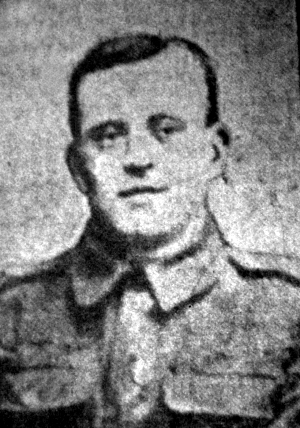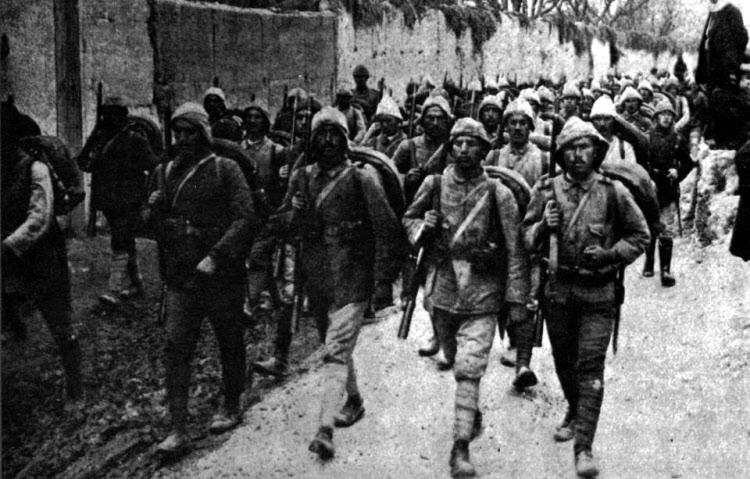
201874, King’s Own Yorkshire Light Infantry, 7th Battalion, attached to the King’s Royal Rifle Corps, 7th Battalion
George Hemingway was born in Ossett on the 6th September 1884, the fourth child, and youngest son of Ossett-born rag grinder Edwin Hemingway and his wife, Leeds-born, Sarah Ann (nee Rhodes), who were married at Dewsbury All Saints Parish Church on the 23rd May 1874. The couple had five children, all born in Ossett. George Hemingway was baptised at Ossett Holy Trinity Church on the 8th July 1891.
In 1891 Edwin Hemingway, a rag shaker, and Sarah were living at Wakefield Road, Sandbeds, Flushdyke, Ossett with their five children. In 1901, their address was South View Terrace, Flushdyke, Ossett where George, now aged 16, was working as a domestic gardener.
On the 20th February 1909 at Ossett Holy Trinity Church, 24 year-old gardener, George Hemingway married 21 year-old spinster Edith Fearnside and they began their married life in two-roomed accommodation at 1, Riley’s Yard, Wakefield Road, Flushdyke, Ossett, where George was working as a dyer’s labourer. They had one child: Frank Fearnside Hemingway, born in February 1911 and they subsequently had a second child: Gladys Fearnside Hemingway in Spring 1915.
The 7th (Service) Battalion of KOYLI was formed at Pontefract on the 12th September 1914 as part of K2 and came under command of 61st Brigade in 20th (Light) Division. The Battalion moved to Woking and then on to Witley in February 1915, going on to Salisbury Plain in May. On the 24th July 1915 they landed at Boulogne and on the 20th February 1918, the battalion was disbanded in France when Private George Hemingway transferred to the 7th Battalion of the King’s Royal Rifle Corps.
In 1918 the 7th Battalion, KRRC with the 14th (Light) Division returned to the Somme and were in action during The Battle of St Quentin (21st to 23rd March) and The Battle of the Avre (4th April), suffering very heavy casualties with almost 6,000 men of the Division killed or injured. The Division was withdrawn from the front line and were engaged building a new defensive line to the rear.
The 7th KRRC was part of 41st Brigade, 14th (Light) Division. On 21st March the 14th (Light) Division was in the front line of the Fifth Army and the 7th Battalion KRRC was in the battle zone near Benay.
On 22nd March the 14th (Light) Division held the Germans on a reduced front on the St. Quentin canal. The enemy crossed at several points on the next day, and the retirement continued on the 24th and 25th. An exhausted remnant, about 2,000 strong, of a fine division reached L’Ecouvillon on the 26th March 1918.
During the retirement, the 7th Battalion KRRC lost 5 officers and 140 other ranks. It is thought that Private George Hemingway was killed during the build up to the Battle of the Avre. The Battle of the Avre (4–5 April 1918) constituted the final German attack towards Amiens in World War I. It was the point at which the Germans got the closest to Amiens. It was fought between attacking German troops and defending Australian and British troops.
George Hemingway’s army service record has not survived, but it is known that he enlisted at Ossett, and that he was posthumously awarded the British and Victory medals. He did not serve overseas before the 31st December 1915 and did not qualify for the 1914/15 Star.
The “Ossett Observer” 1 had this obituary for Private George Hemingway:
“Well-Known Ossett Man’s Fate – Official news came to hand on Monday morning that Private George Hemingway (33), of the King’s Royal Rifles (formerly King’s Own Yorkshire Light Infantry), whose home was at 38, Wakefield Rd., Flushdyke, was killed in action on April 2nd. Deceased leaves a widow and two children. He was well-known locally, and for many years was under-gardener at Longlands, but for a period prior to joining the army in March, 1915, he worked in a mill. It was about sixteen months ago that he went to the front. A few days before receiving the official notice of his death, deceased’s widow was informed of her husband’s fate by a soldier comrade, a Wakefield man, who in conveying the sympathy of the non-commissioned officers and men of the company, said that they all felt they had lost a good friend, one who was ever ready and willing to perform the duties allotted to him, however hard or irksome.”

Above: German storm troopers in action during Operation Michael, the German Spring Offensive that started on the 21st March 1918.
Private George Hemingway was killed in action on the 2nd April 1918 and is remembered on Panels 59 and 60 at the Pozieres Memorial,2 Somme, France. Pozieres is a village 6 kilometres north-east of the town of Albert. The Memorial encloses Pozieres British Cemetery which is a little south-west of the village on the north side of the main road, D929, from Albert to Pozieres.
The Pozieres Memorial relates to the period of crisis in March and April 1918 when the Allied Fifth Army was driven back by overwhelming numbers across the former Somme battlefields, and the months that followed before the Advance to Victory, which began on 8 August 1918.
The Memorial commemorates over 14,000 casualties of the United Kingdom and 300 of the South African Forces who have no known grave and who died on the Somme from 21 March to 7 August 1918. The Corps and Regiments most largely represented are The Rifle Brigade with over 600 names, The Durham Light Infantry with approximately 600 names, the Machine Gun Corps with over 500, The Manchester Regiment with approximately 500 and The Royal Horse and Royal Field Artillery with over 400 names.
The memorial encloses Pozieres British Cemetery, Plot II of which contains original burials of 1916, 1917 and 1918, carried out by fighting units and field ambulances. The remaining plots were made after the Armistice when graves were brought in from the battlefields immediately surrounding the cemetery, the majority of them of soldiers who died in the Autumn of 1916 during the latter stages of the Battle of the Somme, but a few represent the fighting in August 1918.
There are now 2,758 Commonwealth servicemen buried or commemorated in this cemetery. 1,380 of the burials are unidentified but there are special memorials to 23 casualties known or believed to be buried among them. There is also 1 German soldier buried here.
References:
1. “Ossett Observer”, 8th May 1918